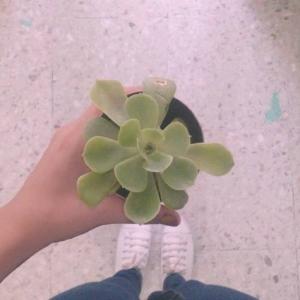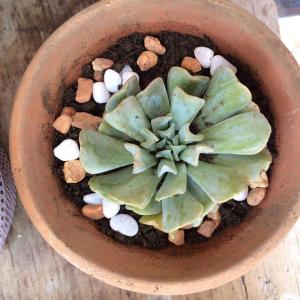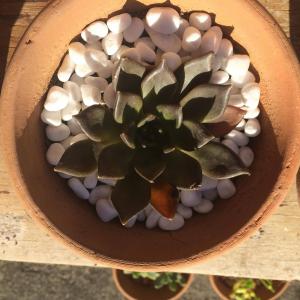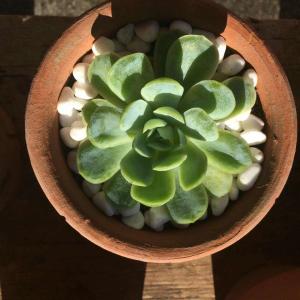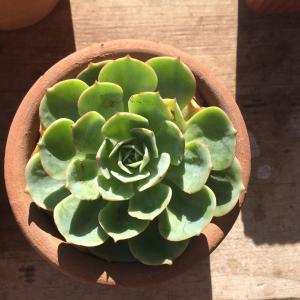成长记
Wendy F. Samonte
2017年09月19日

I new added a "Echeveria Imbricata Rose Cabbage" in my "garden"
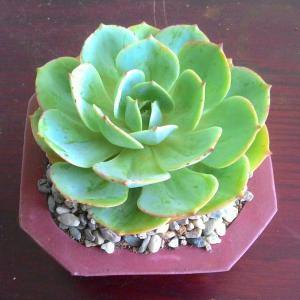

4
0
文章
Dummer. ゛☀
2017年09月18日

Echeveria elegans, also known as Mexican Snowball is a dense, blue-gray succulent species from Mexico that mounds or spreads slowly in tight colonies. Edges of leaves are slightly pink, producing equally pretty small pink flowers with a yellow tinge. Very handsome and uniform in the garden.
Mexican Snowball is aptly named for two reasons: the succulent rosettes are an icy blue color and this species is the hardiest of the Echeveria, a genus of succulents with their center of diversity in Mexico.
The low-growing clusters are very suitable to fill rock crevices and are occasionally used to cover the roof tiles of a house‐top. A layer of rosettes stapled to the roof overhang is used to hold an inch of peaty soil to the roof. It is also used to form silvery blue small borders and are believed to keep away evil spirits.

Growing Conditions
Light: Grow Echeveria elegans in full sun to light shade.
Water: Water moderately when in growth; not at all when dormant.
Temperature: More cold hardy than many other Echeverias, this one makes an excellent rock garden or container plant that needs occasional winter protection below 25°F (-4°C).
Soil: Grow in well-drained soil.
Fertilizer: Apply a balanced liquid fertilizer 2 or 3 times in the growing season.

Grower’s Tips
Mexican Snowball is certainly one of the most versatile neat, low-growing ground cover succulents. It is easy to care for and is a good starting point for beginning gardeners. It is considered to be drought tolerant but it does best with occasional watering in a well drained soil. This is typical of many Echeveria. They can be planted in full sun in coastal areas and they like some light shade when planted inland. Elsewhere grow as a houseplant in winter in a cool, bright window and keep dry until spring.

Propagation
Propagate by seed sown as soon as ripe or by root, stem or leaf cuttings in spring.
Mexican Snowball is aptly named for two reasons: the succulent rosettes are an icy blue color and this species is the hardiest of the Echeveria, a genus of succulents with their center of diversity in Mexico.
The low-growing clusters are very suitable to fill rock crevices and are occasionally used to cover the roof tiles of a house‐top. A layer of rosettes stapled to the roof overhang is used to hold an inch of peaty soil to the roof. It is also used to form silvery blue small borders and are believed to keep away evil spirits.

Growing Conditions
Light: Grow Echeveria elegans in full sun to light shade.
Water: Water moderately when in growth; not at all when dormant.
Temperature: More cold hardy than many other Echeverias, this one makes an excellent rock garden or container plant that needs occasional winter protection below 25°F (-4°C).
Soil: Grow in well-drained soil.
Fertilizer: Apply a balanced liquid fertilizer 2 or 3 times in the growing season.

Grower’s Tips
Mexican Snowball is certainly one of the most versatile neat, low-growing ground cover succulents. It is easy to care for and is a good starting point for beginning gardeners. It is considered to be drought tolerant but it does best with occasional watering in a well drained soil. This is typical of many Echeveria. They can be planted in full sun in coastal areas and they like some light shade when planted inland. Elsewhere grow as a houseplant in winter in a cool, bright window and keep dry until spring.

Propagation
Propagate by seed sown as soon as ripe or by root, stem or leaf cuttings in spring.
1
1
文章
Dummer. ゛☀
2017年09月17日

Echeveria ‘Doris Taylor’, also known as Woolly Rose, is an attractive succulent that forms rosettes of pale-green, fleshy leaves covered with small white hairs. A low-maintenance succulent, the woolly rose can easily thrive if provided with the right conditions. Often grown outside in warm, arid regions, the Woolly Rose is best suited to U.S. Department of Agriculture plant hardiness zones 9b to 11; it should be brought inside during the winter if grown in colder climates.

Growing Conditions and General Care
Place the Woolly Rose where it will receive full morning sun or partially shaded afternoon sunlight. If the it is in a pot, place it out on the balcony or porch during warm, sunny weather. Give the Woolly Rose at least a foot (30 cm) of space on each side to prevent it from being crowded by other plants.
Water whenever the soil feels dry during the growing season. Water lightly until the soil is moist but not very wet. Woolly Rose can go for a long period without water once they are established, but they grow better and faster if they receive regular watering during the growing season. Reduce watering during the winter, allowing the soil to dry thoroughly between waterings.
Fertilize Woolly Rose with liquid 2-7-7 succulent and cactus fertilizer during the growing season, from spring to late summer. Add seven drops of the fertilizer to 1 quart of water and sprinkle around the base of the succulent. Fertilize once every two weeks.
Woolly Rose will drop many of its lower leaves during the winter. Remove shriveled and fallen leaves as they accumulate around the base of the plant. Discard the leaves before they begin to rot. Decaying leaves can spread disease to the rest of the plant if not removed.

Repotting
Repot Woolly Rose plants once roots become visible around drainage holes. Repot into a pot 1 inch (2.5 cm) wider and deeper or out into the garden. Woolly Rose prefer very well-draining soil.

Propagation
Propagate Woolly Rose plants by taking cuttings during the growing season. Cut off a branch and allow it to dry for 24 hours in a warm location with indirect light. Plant the cutting in moist potting soil and place in indirect sunlight or where it will receive direct morning sun. Keep soil moist but not wet. Roots should appear within a few weeks after planting.

Growing Conditions and General Care
Place the Woolly Rose where it will receive full morning sun or partially shaded afternoon sunlight. If the it is in a pot, place it out on the balcony or porch during warm, sunny weather. Give the Woolly Rose at least a foot (30 cm) of space on each side to prevent it from being crowded by other plants.
Water whenever the soil feels dry during the growing season. Water lightly until the soil is moist but not very wet. Woolly Rose can go for a long period without water once they are established, but they grow better and faster if they receive regular watering during the growing season. Reduce watering during the winter, allowing the soil to dry thoroughly between waterings.
Fertilize Woolly Rose with liquid 2-7-7 succulent and cactus fertilizer during the growing season, from spring to late summer. Add seven drops of the fertilizer to 1 quart of water and sprinkle around the base of the succulent. Fertilize once every two weeks.
Woolly Rose will drop many of its lower leaves during the winter. Remove shriveled and fallen leaves as they accumulate around the base of the plant. Discard the leaves before they begin to rot. Decaying leaves can spread disease to the rest of the plant if not removed.

Repotting
Repot Woolly Rose plants once roots become visible around drainage holes. Repot into a pot 1 inch (2.5 cm) wider and deeper or out into the garden. Woolly Rose prefer very well-draining soil.

Propagation
Propagate Woolly Rose plants by taking cuttings during the growing season. Cut off a branch and allow it to dry for 24 hours in a warm location with indirect light. Plant the cutting in moist potting soil and place in indirect sunlight or where it will receive direct morning sun. Keep soil moist but not wet. Roots should appear within a few weeks after planting.
0
1
文章
Dummer. ゛☀
2017年09月17日

Each succulent stands out in its own way — the variegated foliage of Aeonium, the size and grandeur of Agave, the cold-hardiness and resilience of Sempervivum. Out-of-this-world color and year-round beauty belong to Echeveria.

Hailing from semi desert regions of Mexico and of Central and South America, Echeveria thrives in the mild climates of California and the American Southwest. Its colorful, glaucous foliage and year-after-year flowering makes it one of the most popular succulent types. Cold sensitivity may be a concern for many gardeners, but conveniently enough, Echeveria makes a great container plant. Once fall rolls in, just pack up and bring it indoors. Welcome your containers back into the garden in spring.

Where it will grow: Hardy to around 32 degrees Fahrenheit (0 degrees Celsius), depending on species (USDA zones 9a to 11b).
Water requirement: Looks best with moderate water.
Light requirement: Full sun, but shelter it from harsh summer sun.
Mature size: Varies with species.
Benefits and tolerances: Drought tolerant; deer resistant.
Seasonal interest: Evergreen; flowers in summer.
When to plant: Plant cuttings or offsets spring through fall; allow the stem end to become callous.

Distinguishing Traits
Echeveria is rosette forming, with fleshy green leaves in colors ranging from green to gray-green to purple, with colored tips and other quirky accents augmenting its playful demeanor. The color remains strong year-round, and even in the dark grays of winter, your garden will receive a nice pink foliage pick-me-up.
Unlike many succulents, Echeverias are not monocarpic and can flower several times throughout a lifetime. In summer look for a stem of clustered flowers, often in bright pinks and yellows.

How to Use It
Plant Echeveria en masse, as a container specimen or along a rocky bank. Depending on your climate zone and style preference, the options are pretty open.
Echeverias are commonly planted in containers. Their portability makes summer and winter maintenance that much easier.
If summer climates are more extreme, shelter plants from direct sunlight. Likewise, bring your Echeveria indoors if your climate experiences freezing winters. Be sure to provide ample direct light.
Echeverias are also used in living walls for sunny locations.

Planting Notes
Echeverias look healthiest and develop the best year-round color when planted in full, coastal sun.
Some Echeverias develop tall stalks, and eventually you may want to cut and reroot the rosette, much like is done with Aeonium. Leave the stalk and new Echeverias will sprout. Others produce offsets, which can also be used to propagate.
Try to avoid extreme light and temperature swings while providing good air circulation and good light. Give it some water but not too much, and otherwise let it do its thing.

Hailing from semi desert regions of Mexico and of Central and South America, Echeveria thrives in the mild climates of California and the American Southwest. Its colorful, glaucous foliage and year-after-year flowering makes it one of the most popular succulent types. Cold sensitivity may be a concern for many gardeners, but conveniently enough, Echeveria makes a great container plant. Once fall rolls in, just pack up and bring it indoors. Welcome your containers back into the garden in spring.

Where it will grow: Hardy to around 32 degrees Fahrenheit (0 degrees Celsius), depending on species (USDA zones 9a to 11b).
Water requirement: Looks best with moderate water.
Light requirement: Full sun, but shelter it from harsh summer sun.
Mature size: Varies with species.
Benefits and tolerances: Drought tolerant; deer resistant.
Seasonal interest: Evergreen; flowers in summer.
When to plant: Plant cuttings or offsets spring through fall; allow the stem end to become callous.

Distinguishing Traits
Echeveria is rosette forming, with fleshy green leaves in colors ranging from green to gray-green to purple, with colored tips and other quirky accents augmenting its playful demeanor. The color remains strong year-round, and even in the dark grays of winter, your garden will receive a nice pink foliage pick-me-up.
Unlike many succulents, Echeverias are not monocarpic and can flower several times throughout a lifetime. In summer look for a stem of clustered flowers, often in bright pinks and yellows.

How to Use It
Plant Echeveria en masse, as a container specimen or along a rocky bank. Depending on your climate zone and style preference, the options are pretty open.
Echeverias are commonly planted in containers. Their portability makes summer and winter maintenance that much easier.
If summer climates are more extreme, shelter plants from direct sunlight. Likewise, bring your Echeveria indoors if your climate experiences freezing winters. Be sure to provide ample direct light.
Echeverias are also used in living walls for sunny locations.

Planting Notes
Echeverias look healthiest and develop the best year-round color when planted in full, coastal sun.
Some Echeverias develop tall stalks, and eventually you may want to cut and reroot the rosette, much like is done with Aeonium. Leave the stalk and new Echeverias will sprout. Others produce offsets, which can also be used to propagate.
Try to avoid extreme light and temperature swings while providing good air circulation and good light. Give it some water but not too much, and otherwise let it do its thing.
2
1





